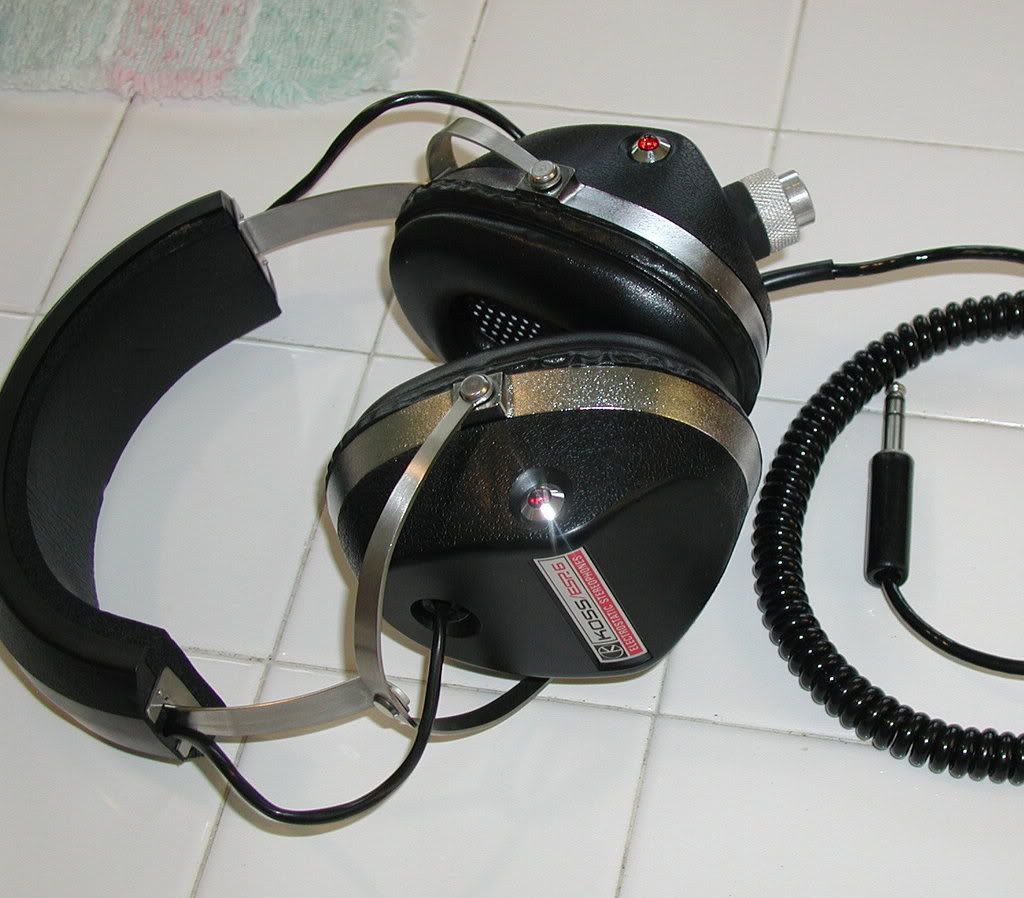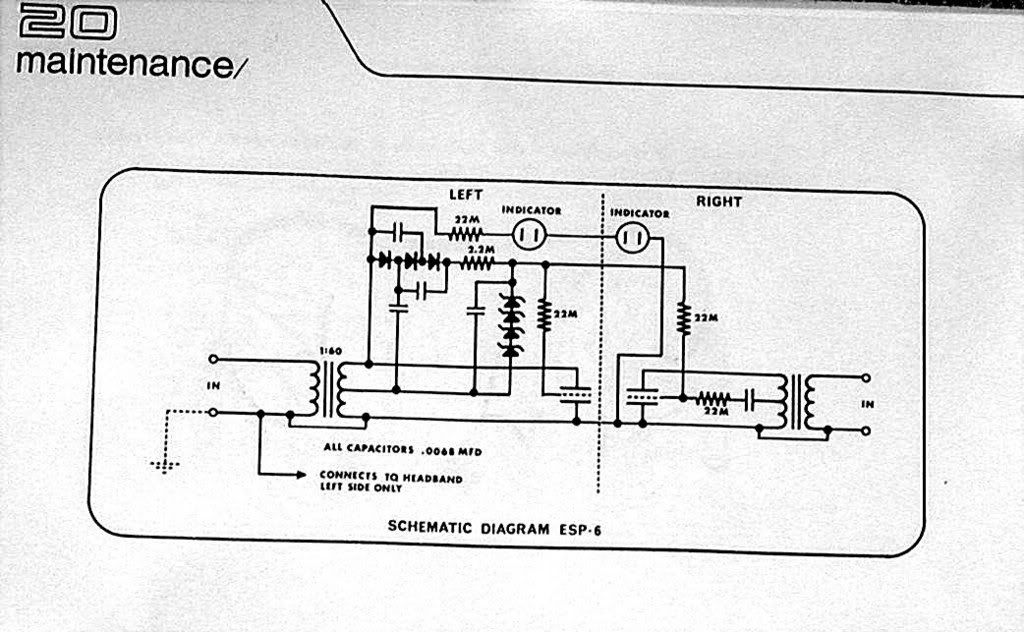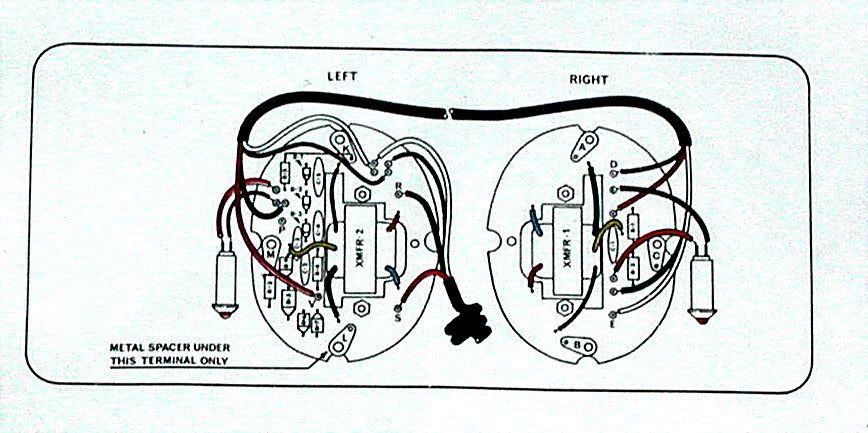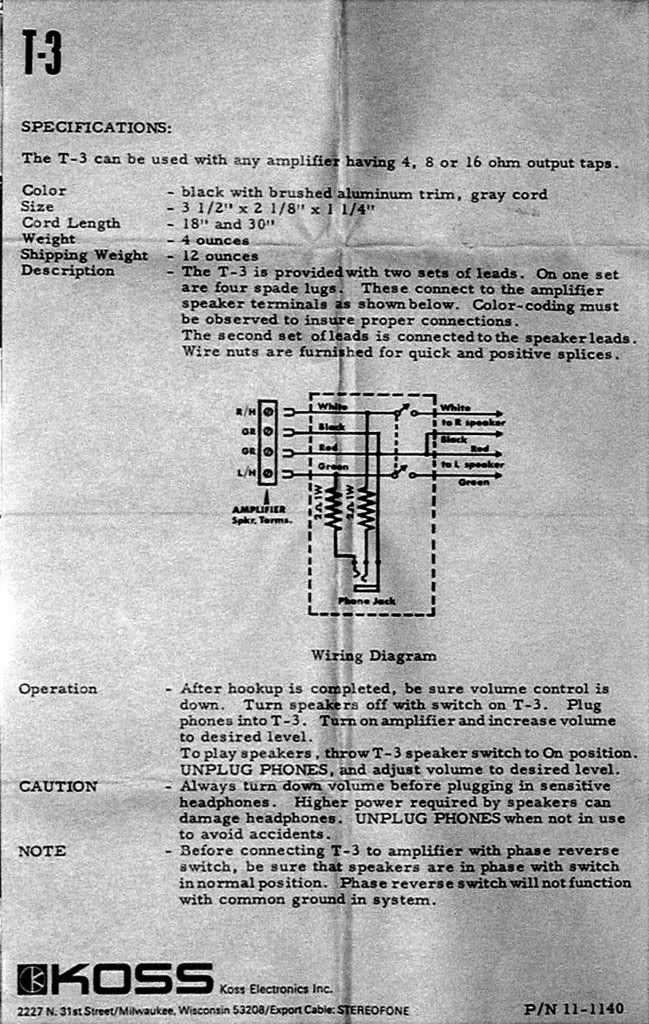- Joined
- Sep 7, 2002
- Posts
- 3,137
- Likes
- 217
The Koss ESP6 is the first electrostatic headphone made by Koss, back in the Jurassic period. Its age, size and weight make it a veritable dinosaur of headphones. However, to anticipate what follows, it shows up surprisingly well against more recent and more highly regarded products and it is more than a vintage phones curiosity piece.

The ESP6 was introduced in 1968 and phased out in 1973 according to the Koss website.
http://www.koss.com/koss/kossweb.nsf...m&60s^Products
Prior to this, Stax had made only one electrostatic
model, the SR-1.
http://www.stax.co.jp/Export/History.html
I had bought an ESP6a more than 20 years ago. In fact it was the first headphone I ever bought. I later sold it and moved on to the Koss ESP9 and several Staxen.
The ESP6 and 6a are, as best I can tell, identical, although I am sure there are some minor circuit design changes. They are probably the heaviest headphones ever sold, almost 2 lbs in weight. I am not sure if even the Jecklin Float
http://www.head-fi.org/forums/showthread.php?t=236434
is heavier.
The weight of the ESP6 comes principally from Koss' decision to put the transformers, needed to allow these to be run from a regular power amp, in the earcups themselves. Evidently Koss felt that users would prefer this to a separate transformer box, employed by Stax and later by Koss to in the ESP9. The effect is somewhat spoiled because these phones still come with a small adapter box, which evidently is mainly used to protect the phones from the full power of a regular power amplifier.
While these phones have a large regular stereo headphone plug, they tend not to run well from a conventional jack. Koss suggests removing the protective resistors found in most such set-ups and putting a smaller value resistor (2-5 Ohms) in each channel.
These phones are also self-biased, i.e. the additional charge applied to the diaphragm is generated from a portion of the musical signal, versus being powered separately from the mains. I am not sure who first came up with this feature, certainly Stax also has used this feature. The ESP manual implies that Koss pioneered this. I can't tell from the Stax site, whether or not their earlier models were self-biased or mains powered.
The current pair was sold on Ebay a few weeks ago. When I got them, I didn't have great expectations for them, because I was aware of the tendency for these early Koss phones to deteriorate. Evidently, the foam used as damping has a tendency to rot, short circuiting the electronics in the earphone cups. As well, Koss had used liquid-filled earpads, which generally leaked after a few years, often into the phones. Thus you faced the additional problem that the electrostatic transducers could be ruined by the liquid. This may also be why the foam itself rotted so badly.
Anyway, for $37.00 I thought they were worth a try.
I know nothing about the history of this particular set except that it came looking almost like new, except for the deflated earpads. I was able to purchase e new set of conventional, i.e. no liquid filled earpads, from Koss for $5.00
A test strip came with the set showing that they were made in 1969.

The test results look amazingly flat, however this was run with a coupler rather than a dummy head, so it would not totally reflect what your ear is likely to hear. On the other hand it is not bad either and I think it is remarkable that there was a time when headphones came with individual test results attached!
Their sound out of the shipping parcel was not good. You could hear something, but it was very distorted with the volume surging.
On the good side, I noted that the sound, crappy as it be, was balanced in both ears and that the diaphragms seemed to be intact. You could tell this because pressing each cup produced a static burst (some call it the electrostatic fart). This is caused by the air pressure of the movement pushing the diaphragm to the outer stator, thus creating an audible static discharge. This is a usually harmless characteristic of most electrostatic designs. I heard this as a sign of intact diaphragms, because if they were torn or punctured, they will leak and won't move to the outer stator.
THE CLEAN-UP
I remembered that a few years back, either on this site or HEADWIZE, someone had sent in a post indicating that old Koss phones could be brought back to good running order if they were cleaned up, especially the circuit boards, because of the above- mentioned problem with rotten foam. He believed that the foam actually short circuited the circuits. At any rate he got his Koss working, a set of ESP 9's if I recall correctly.
Other persons on this site have set to work to rehab various ESP9's, but I have not yet heard of a 6 being brought back to its original operating characteristics.
Upon opening the cups, I found the expected gooey mess. I took the circuit boards out of each cup, and cleaned them with contact cleaner. I also removed every crimped contact and cleaned them with Progold contact enhancer. I scrapped off the crud from any contact surfaces .
The photos show the component side of each board. Note the transformers built in each cup.


I have done three cleanings so far. With the last I am starting to get something like HiFi sound at last. In particular, the mid and upper frequencies have come back with considerable definition.
BIAS/VOLUME ISSUES
On first hearing, the volume drove up and down badly. This is almost certainly due to problems with the self-biasing operation. While the bias charge is supposed to be currentless (Koss' term) in fact it leaks out. With a dirty set like the present, evidently there is so much leakage that the sound goes up as the set is charged, and then the bias charge drops off almost immediately. However with each cleaning, this has become less of an issue and the phones are pretty stable now for most rock/pop music and even a lot of classical, which is more difficult because of the wide dynamics in much classical music.
I would say these phones are pretty good now, and I may experiment with means of making the bias more stable. Anyone know if larger capacitors would help?
THE SOUND
I let everything warm up for an hour before making comparisons. It's been more than 20 years since I last had a pair of these phones, so it's hard to recall exactly how they sounded. Still, my general impression is that the ESP6 sound now pretty much like what I recall from the ESP6a. I put on Roberta Flack's "Killing Me Softly" which I used to use to demonstrate the 6a's and it sounded like the same glorious intro, with the ringing bell sounds and smooth background vocals. I spent some time going back and forth between the ESP6 and a Stax 404 and Stax Sigma/404 (a Sigma rebuilt with the newer 404 cable and drivers.
http://www.head-fi.org/forums/showth...15&highlight=s igma%2F404
I used the previously-mentioned Roberta Flack, a Mahler symphony and Russian and Christmas Choral music. The ESP6 was generally as much up to the task as the Stax, except in the Christmas music, a somewhat disappointing Telarc recording of the Mormon Tabernacle choir, in which several tracks sounded murkier with the ESP6 than the Stax.
Each of the phones had a somewhat similar frequency extent, i.e. much the same range from top to bottom. The Sigma/404 has more upper mid bass and better "air" around the instruments/voices and a beautiful ambience and openness. The 404 less air, more bass punch than either of the other 2 phones. For the last few months I have been ambivalent as to which of the 2 Stax was best. When the Sigma/404 arrived I felt it was the best phones I had and that the 404 was somewhat harsh sounding. A recent tweak, the use of Silclear contact enhancer on all contacts, really helped the harshness of the 404 as well as an older Nova Lambda, and the 404 may have moved ahead of the Sigma/404 in performance because of its overall better definition. The Sigma/404 has a more diffuse sounding as a result of its unusual front mounted drivers, but basically they are both great phones, each being better with different source materials.
The ESP6 was somewhat muddy in the bass, with less bass punch, less clearly defined instruments/voices and generally lacking the airiness of the two Stax. However what it does have something that neither of the Stax have, more smoothness to the sound. In other words, the Stax have a slight raspiness compared to the Koss.
COMPARISON WITH STAX 404, SIGMA 404
It is hard to make direct comparison with phones run from a different amplifying system. While the Stax and Koss phones are hooked up to the same source, the amplification differences favour the Stax phones.
The system I am using here consists of a CEC TL5100Z (used as a cd transport) with a Musical Fidelity A324K DAC plus Monarchy jitter reducer. The DAC feeds a Stax 717 amp, which runs the two Stax phones. An output from the Stax runs to a Pioneer 50 W/CH receiver. The Koss ESP6 is connected to the Pioneer through the Koss adapter box which is plugged into one of the speaker outlets of the Pioneer.
The amplification is not really comparable here. For a start the Stax 717, even bought direct from Japan cost about 10 times the Pioneer receiver. The Stax is class A, the Pioneer a conventional amp. As well, the 717 is fed directly from the DAC, the Pioneer has one addition connecter stage. The physical set-up made it hard to run the connections direct to the Pioneer.
Several contributors have recently been raving about another old phone, the Stax SRX3 run from amps through an amplifier and transfomer adapter box, compared to various Stax headphone amplifiers. Clearly a lot will depend on the quality of the amp.
I tried to check the quality of the Pioneer by running a dynamic phone from the headphone jack, the Sennheisser CX300. It sounded too grainy by comparison with electrostatics so that this comparison made no sense.
COMFORT ISSUES
Weighing in at almost 2 lbs, these are not phones you are likely to want to boogy with. They also fit very tightly, although you can bend back the metal bands to a better comfort level. They are quite isolating, and sometimes that is good. I can listen to these in bed with my wife asleep, without disturbing her. In fact listening on a bed with a soft pillow is the ideal way to use these phones, the weight is fully supported and the listening experience is very comfortable. You can not do this with the Stax because they are open back and any close surfaces, such as the pillow will cause a backwave which will muddy up the sound.
CONCLUSION
The ESP6 remains an interesting product almost 40 years after it was made. It has much of the clarity one expects from an electrostatic with good treble and bass extension. It lacks the "airiness" of the comparison phones and has a more congested sound in complex passages. However, it has smoothness that the other Stax lack and they show some harshness by comparison.
If I had to run out of the house on fire and could only grab one set, I would still grab the Sigma/404, because of its sound quality and rarity.
However, if you can get a working pair of ESP6 under $100.00, you might very well find use for them. They are fine with rock/pop but really need some work on their bias problem to be considered a good all-around set of headphones.
Below is a schematic and board diagram for anyone else working with these.


I am adding the 2 photos below to show the adapter box and its schematic.



The ESP6 was introduced in 1968 and phased out in 1973 according to the Koss website.
http://www.koss.com/koss/kossweb.nsf...m&60s^Products
Prior to this, Stax had made only one electrostatic
model, the SR-1.
http://www.stax.co.jp/Export/History.html
I had bought an ESP6a more than 20 years ago. In fact it was the first headphone I ever bought. I later sold it and moved on to the Koss ESP9 and several Staxen.
The ESP6 and 6a are, as best I can tell, identical, although I am sure there are some minor circuit design changes. They are probably the heaviest headphones ever sold, almost 2 lbs in weight. I am not sure if even the Jecklin Float
http://www.head-fi.org/forums/showthread.php?t=236434
is heavier.
The weight of the ESP6 comes principally from Koss' decision to put the transformers, needed to allow these to be run from a regular power amp, in the earcups themselves. Evidently Koss felt that users would prefer this to a separate transformer box, employed by Stax and later by Koss to in the ESP9. The effect is somewhat spoiled because these phones still come with a small adapter box, which evidently is mainly used to protect the phones from the full power of a regular power amplifier.
While these phones have a large regular stereo headphone plug, they tend not to run well from a conventional jack. Koss suggests removing the protective resistors found in most such set-ups and putting a smaller value resistor (2-5 Ohms) in each channel.
These phones are also self-biased, i.e. the additional charge applied to the diaphragm is generated from a portion of the musical signal, versus being powered separately from the mains. I am not sure who first came up with this feature, certainly Stax also has used this feature. The ESP manual implies that Koss pioneered this. I can't tell from the Stax site, whether or not their earlier models were self-biased or mains powered.
The current pair was sold on Ebay a few weeks ago. When I got them, I didn't have great expectations for them, because I was aware of the tendency for these early Koss phones to deteriorate. Evidently, the foam used as damping has a tendency to rot, short circuiting the electronics in the earphone cups. As well, Koss had used liquid-filled earpads, which generally leaked after a few years, often into the phones. Thus you faced the additional problem that the electrostatic transducers could be ruined by the liquid. This may also be why the foam itself rotted so badly.
Anyway, for $37.00 I thought they were worth a try.
I know nothing about the history of this particular set except that it came looking almost like new, except for the deflated earpads. I was able to purchase e new set of conventional, i.e. no liquid filled earpads, from Koss for $5.00
A test strip came with the set showing that they were made in 1969.

The test results look amazingly flat, however this was run with a coupler rather than a dummy head, so it would not totally reflect what your ear is likely to hear. On the other hand it is not bad either and I think it is remarkable that there was a time when headphones came with individual test results attached!
Their sound out of the shipping parcel was not good. You could hear something, but it was very distorted with the volume surging.
On the good side, I noted that the sound, crappy as it be, was balanced in both ears and that the diaphragms seemed to be intact. You could tell this because pressing each cup produced a static burst (some call it the electrostatic fart). This is caused by the air pressure of the movement pushing the diaphragm to the outer stator, thus creating an audible static discharge. This is a usually harmless characteristic of most electrostatic designs. I heard this as a sign of intact diaphragms, because if they were torn or punctured, they will leak and won't move to the outer stator.
THE CLEAN-UP
I remembered that a few years back, either on this site or HEADWIZE, someone had sent in a post indicating that old Koss phones could be brought back to good running order if they were cleaned up, especially the circuit boards, because of the above- mentioned problem with rotten foam. He believed that the foam actually short circuited the circuits. At any rate he got his Koss working, a set of ESP 9's if I recall correctly.
Other persons on this site have set to work to rehab various ESP9's, but I have not yet heard of a 6 being brought back to its original operating characteristics.
Upon opening the cups, I found the expected gooey mess. I took the circuit boards out of each cup, and cleaned them with contact cleaner. I also removed every crimped contact and cleaned them with Progold contact enhancer. I scrapped off the crud from any contact surfaces .
The photos show the component side of each board. Note the transformers built in each cup.


I have done three cleanings so far. With the last I am starting to get something like HiFi sound at last. In particular, the mid and upper frequencies have come back with considerable definition.
BIAS/VOLUME ISSUES
On first hearing, the volume drove up and down badly. This is almost certainly due to problems with the self-biasing operation. While the bias charge is supposed to be currentless (Koss' term) in fact it leaks out. With a dirty set like the present, evidently there is so much leakage that the sound goes up as the set is charged, and then the bias charge drops off almost immediately. However with each cleaning, this has become less of an issue and the phones are pretty stable now for most rock/pop music and even a lot of classical, which is more difficult because of the wide dynamics in much classical music.
I would say these phones are pretty good now, and I may experiment with means of making the bias more stable. Anyone know if larger capacitors would help?
THE SOUND
I let everything warm up for an hour before making comparisons. It's been more than 20 years since I last had a pair of these phones, so it's hard to recall exactly how they sounded. Still, my general impression is that the ESP6 sound now pretty much like what I recall from the ESP6a. I put on Roberta Flack's "Killing Me Softly" which I used to use to demonstrate the 6a's and it sounded like the same glorious intro, with the ringing bell sounds and smooth background vocals. I spent some time going back and forth between the ESP6 and a Stax 404 and Stax Sigma/404 (a Sigma rebuilt with the newer 404 cable and drivers.
http://www.head-fi.org/forums/showth...15&highlight=s igma%2F404
I used the previously-mentioned Roberta Flack, a Mahler symphony and Russian and Christmas Choral music. The ESP6 was generally as much up to the task as the Stax, except in the Christmas music, a somewhat disappointing Telarc recording of the Mormon Tabernacle choir, in which several tracks sounded murkier with the ESP6 than the Stax.
Each of the phones had a somewhat similar frequency extent, i.e. much the same range from top to bottom. The Sigma/404 has more upper mid bass and better "air" around the instruments/voices and a beautiful ambience and openness. The 404 less air, more bass punch than either of the other 2 phones. For the last few months I have been ambivalent as to which of the 2 Stax was best. When the Sigma/404 arrived I felt it was the best phones I had and that the 404 was somewhat harsh sounding. A recent tweak, the use of Silclear contact enhancer on all contacts, really helped the harshness of the 404 as well as an older Nova Lambda, and the 404 may have moved ahead of the Sigma/404 in performance because of its overall better definition. The Sigma/404 has a more diffuse sounding as a result of its unusual front mounted drivers, but basically they are both great phones, each being better with different source materials.
The ESP6 was somewhat muddy in the bass, with less bass punch, less clearly defined instruments/voices and generally lacking the airiness of the two Stax. However what it does have something that neither of the Stax have, more smoothness to the sound. In other words, the Stax have a slight raspiness compared to the Koss.
COMPARISON WITH STAX 404, SIGMA 404
It is hard to make direct comparison with phones run from a different amplifying system. While the Stax and Koss phones are hooked up to the same source, the amplification differences favour the Stax phones.
The system I am using here consists of a CEC TL5100Z (used as a cd transport) with a Musical Fidelity A324K DAC plus Monarchy jitter reducer. The DAC feeds a Stax 717 amp, which runs the two Stax phones. An output from the Stax runs to a Pioneer 50 W/CH receiver. The Koss ESP6 is connected to the Pioneer through the Koss adapter box which is plugged into one of the speaker outlets of the Pioneer.
The amplification is not really comparable here. For a start the Stax 717, even bought direct from Japan cost about 10 times the Pioneer receiver. The Stax is class A, the Pioneer a conventional amp. As well, the 717 is fed directly from the DAC, the Pioneer has one addition connecter stage. The physical set-up made it hard to run the connections direct to the Pioneer.
Several contributors have recently been raving about another old phone, the Stax SRX3 run from amps through an amplifier and transfomer adapter box, compared to various Stax headphone amplifiers. Clearly a lot will depend on the quality of the amp.
I tried to check the quality of the Pioneer by running a dynamic phone from the headphone jack, the Sennheisser CX300. It sounded too grainy by comparison with electrostatics so that this comparison made no sense.
COMFORT ISSUES
Weighing in at almost 2 lbs, these are not phones you are likely to want to boogy with. They also fit very tightly, although you can bend back the metal bands to a better comfort level. They are quite isolating, and sometimes that is good. I can listen to these in bed with my wife asleep, without disturbing her. In fact listening on a bed with a soft pillow is the ideal way to use these phones, the weight is fully supported and the listening experience is very comfortable. You can not do this with the Stax because they are open back and any close surfaces, such as the pillow will cause a backwave which will muddy up the sound.
CONCLUSION
The ESP6 remains an interesting product almost 40 years after it was made. It has much of the clarity one expects from an electrostatic with good treble and bass extension. It lacks the "airiness" of the comparison phones and has a more congested sound in complex passages. However, it has smoothness that the other Stax lack and they show some harshness by comparison.
If I had to run out of the house on fire and could only grab one set, I would still grab the Sigma/404, because of its sound quality and rarity.
However, if you can get a working pair of ESP6 under $100.00, you might very well find use for them. They are fine with rock/pop but really need some work on their bias problem to be considered a good all-around set of headphones.
Below is a schematic and board diagram for anyone else working with these.


I am adding the 2 photos below to show the adapter box and its schematic.


























